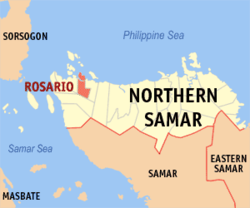Rosario | |
|---|---|
| Municipality of Rosario | |
 Map of Northern Samar with Rosario highlighted | |
Location within the Philippines | |
| Coordinates: 12°31′N124°25′E / 12.52°N 124.42°E | |
| Country | Philippines |
| Region | Eastern Visayas |
| Province | Northern Samar |
| District | 1st district |
| Barangays | 11 (see Barangays) |
| Government | |
| • Type | Sangguniang Bayan |
| • Mayor | David A. Bido |
| • Vice Mayor | Vicente B. Arillo Jr. |
| • Representative | Paul R. Daza |
| • Councilors | List |
| • Electorate | 9,361 voters (2025) |
| Area | |
• Total | 31.60 km2 (12.20 sq mi) |
| Elevation | 35 m (115 ft) |
| Highest elevation | 271 m (889 ft) |
| Lowest elevation | −2 m (−7 ft) |
| Population (2024 census) [3] | |
• Total | 11,726 |
| • Density | 370/km2 (960/sq mi) |
| • Households | 2,438 |
| Economy | |
| • Income class | 5th municipal income class |
| • Poverty incidence | 26.27 |
| • Revenue | ₱ 84.9 million (2022) |
| • Assets | ₱ 259.6 million (2022) |
| • Expenditure | ₱ 64.94 million (2022) |
| • Liabilities | ₱ 85.9 million (2022) |
| Service provider | |
| • Electricity | Northern Samar Electric Cooperative (NORSAMELCO) |
| Time zone | UTC+8 (PST) |
| ZIP code | 6416 |
| PSGC | |
| IDD : area code | +63 (0)55 |
| Native languages | Waray Tagalog |
Rosario, officially the Municipality of Rosario (Waray : Bungto han Rosario; Tagalog : Bayan ng Rosario), is a municipality in the province of Northern Samar, Philippines. According to the 2020 census, it has a population of 10,949 people. [5]
Contents
It is bordered in the west by Lavezares and Victoria to the south. Its coastal area is protected as part of the Biri Larosa Protected Landscape and Seascape.


